December 12, 2015
The Branding of Universities: What is Your University's "Global Brand Value" ?
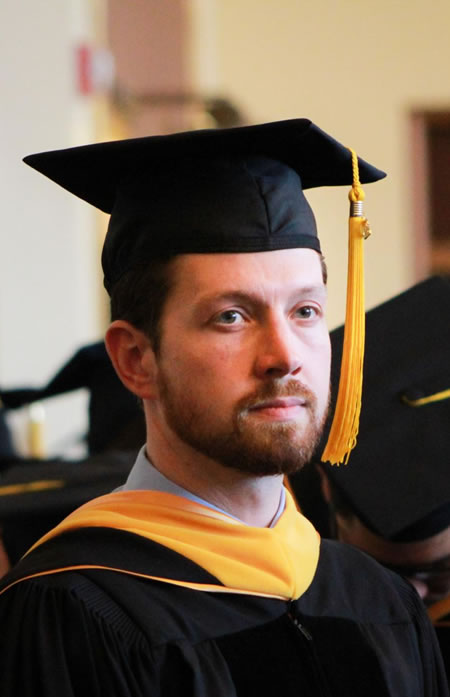
Photo: University of Michigan Commencement 2015. Image Credit & Copyright © University of Michigan.

Photo: Harvard University Commencement 1982, Cambridge, Massachusetts. Harvard University has replaced the University of Cambridge at the top of the global ranking that measures how universities perform on graduate employability. Photographer, Image Credit & Copyright © Paul.
Nowadays, students, whatever their nationality, are increasingly choosing to apply to universities with strong brands over electing a university because it is in their own country or a specific other. That is to say, a student will choose for instance Harvard (US) or McGill (Canada) because they have become strong international brands recognised everywhere by recruiters, thus guaranteeing employability.
Which universities stand out in preparing graduates for the job market?
To answer the above question, the Global Employability University Survey and Ranking 2015 was designed and commissioned by French human resources consulting agency Emerging and carried out by the German market research firm Trendence.
Created from the combined votes of 2,200 recruiters and 2,400 managing directors of international companies across 20 countries, the Global Employability University Ranking differs from other rankings in that it doesn’t take into account academic criteria; it only seeks to represent the point of view of the market.
The Global Employability University Ranking 2015 Results - Top 150
Rank — Institution — Country — Score
- Harvard University — United States — 662
- University of Cambridge — United Kingdom — 633
- University of Oxford — United Kingdom — 609
- California Institute of Technology — United States — 597
- Yale University — United States — 575
- Massachusetts Institute of Technology — United States — 571
- Stanford University — United States — 552
- Columbia University — United States — 531
- Princeton University — United States — 509
- University of Toronto — Canada — 483
- Technical University of Munich — Germany — 411
- University of Tokyo — Japan — 398
- Ecole Normale Superieure — France — 386
- Hong Kong University of Science and Technology — Hong Kong — 378
- Imperial College London — United Kingdom — 369
- Peking University — China — 363
- National University of Singapore — Singapore — 360
- Duke University — United States — 348
- University of California, Berkeley — United States — 333
- Indian Institute of Science — India — 332
- McGill University — Canada — 319
- Mines Paris Tech — France — 308
- University of Edinburgh — United Kingdom — 296
- University of Manchester — United Kingdom — 288
- HEC Paris — France — 278
- Tokyo Institute of Technology — Japan — 273
- IE University — Spain — 270
- Johns Hopkins University — United States — 263
- New York University — United States — 262
- University College London — United Kingdom — 261
- Boston University — United States — 249
- Australian National University — Australia — 243
- University of Melbourne — Australia — 242
- Fudan University — China — 240
- Centrale Supelec — France — 238
- Ecole Polytechnique — France — 236
- ETH Zurich - Swiss Federal Institute of Technology Zurich — Switzerland — 235
- Cornell University — United States — 228
- University of British Columbia — Canada — 223
- Heidelberg University — Germany — 222
- LMU Munich — Germany — 220
- University of Sydney — Australia — 219
- King’s College London — United Kingdom — 218
- University of Montreal — Canada — 216
- London School of Economics and Political Science — United Kingdom — 215
- Boston College — United States — 212
- Goethe University Frankfurt — Germany — 208
- University of California, Los Angeles — United States — 205
- Ghent University — Belgium — 203
- London Business School — United Kingdom — 202
- Ecole Polytechnique Federale de Lausanne — Switzerland — 201
- University of Copenhagen — Denmark — 199
- Kyoto University — Japan — 197
- University of Chicago — United States — 195
- University of New South Wales — Australia — 194
- Monash University — Australia — 192
- Shanghai Jiao Tong University — China — 191
- University of Navarra — Spain — 190
- Tsinghua University — China — 189
- Chinese University of Hong Kong — Hong Kong — 188
- University of California, San Francisco — United States — 187
- KU Leuven — Belgium — 185
- Dartmouth College — United States — 183
- Ecole de Management de Lyon — France — 182
- ESSEC Business School — France — 180
- Stockholm University — Sweden — 178
- Humboldt University of Berlin — Germany — 176
- University of Zurich — Switzerland — 175
- Brown University — United States — 175
- Indian School of Business — India — 174
- University of California, San Diego — United States — 173
- University of Helsinki — Finland — 172
- University of Pennsylvania — United States —169
- University of Bristol — United Kingdom —168
- Delft University of Technology — Netherlands — 165
- Michigan State University — United States — 165
- Carnegie Mellon University — United States — 164
- University of Nottingham — United Kingdom — 163
- Georgetown University — United States — 162
- University of Birmingham — United Kingdom — 161
- University of Sao Paulo — Brazil — 160
- Frankfurt School of Finance and Management — Germany — 158
- University of Hong Kong — Hong Kong — 157
- Lund University — Sweden — 155
- Erasmus University Rotterdam — Netherlands — 154
- McMaster University — Canada — 153
- University of Gottingen — Germany — 151
- Korea Advanced Institute of Science and Technology — Korea Republic — 149
- Northwestern University — United States — 148
- Indian Institute of Technology Bombay — India — 146
- University of Washington — United States — 144
- Hebrew University of Jerusalem — Israel — 143
- Technical University of Berlin — Germany — 141
- Bocconi University — Italy — 138
- University of Lausanne — Switzerland — 135
- National Taiwan University of Science and Technology — Taiwan — 133
- Case Western Reserve University — United States — 130
- Ohio State University — United States — 129
- University of Southern California — United States — 127
- KTH Royal Institute of Technology — Sweden — 126
- University of Texas at Austin — United States — 125
- University of Bern — Switzerland — 125
- Eindhoven University of Technology — Netherlands — 124
- Leiden University — Netherlands — 123
- Pierre and Marie Curie University — France — 122
- ESADE Business School — Spain — 121
- Polytechnic University of Milan — Italy — 120
- Texas A&M University — United States — 119
- Monterrey Institute of Technology and Higher Education — Mexico — 118
- Getulio Vargas Foundation — Brazil — 117
- Rice University — United States — 116
- Pohang University of Science and Technology — Korea Republic — 115
- Technical University of Denmark — Denmark — 115
- University of Groningen — Netherlands — 114
- Paris-Sud University — France — 113
- Brigham Young University — United States — 113
- Seoul National University — Korea Republic — 112
- Nanyang Technological University — Singapore — 112
- Purdue University — United States — 111
- University of Alberta — Canada — 111
- Trinity College Dublin — Ireland — 111
- Osaka University — Japan — 110
- National Autonomous University of Mexico — Mexico — 110
- Rutgers, the State University of New Jersey — United States — 109
- Karolinska Institute — Sweden — 109
- Nanjing University — China — 109
- Zhejiang University — China — 108
- University of Florida — United States — 108
- Lomonosov Moscow State University — Russian Federation — 108
- University of Michigan — United States — 108
- Georgia Institute of Technology — United States — 108
- Keio University — Japan — 107
- Scuola Normale Superiore di Pisa — Italy — 107
- University of Basel — Switzerland — 106
- Technion Israel Institute of Technology — Israel — 105
- Sciences Po — France — 104
- Yonsei University — Korea Republic of — 103
- National Taiwan University — Taiwan — 101
- University of Wisconsin-Madison — United States — 99
- University of Auckland — New Zealand — 98
- University of Oslo — Norway — 96
- Saint Petersburg State University — Russian Federation — 95
- University of Geneva — Switzerland — 94
- National Tsing Hua University — Taiwan — 93
- City University of Hong Kong — Hong Kong — 89
- Tel Aviv University — Israel — 87
- University of Science and Technology of China — China — 78
- Bauman Moscow State Technical University — Russian Federation — 78
- University of Vienna — Austria — 74
- King Saud University — Saudi Arabia — 73
|GlobalGiants.Com|







Edited & Posted by Editor | 11:16 AM | Link to this Post
December 11, 2015
47 cities join the UNESCO Creative Cities Network

Photo: Starstruck. Austin, Texas. Austin has just been designated UNESCO Creative City of Media Arts. Photographer, Image Credit & Copyright © Thomas Hawk.
Paris, 11 December 2015 - UNESCO Director-General, Irina Bokova, has announced the designation of 47 cities from 33 countries as new members of the UNESCO Creative Cities Network. The results of this year’s Call bears witness to the Network’s enhanced diversity and geographical representation with 22 cities from countries not previously represented.
The UNESCO Creative Cities Network has welcomed the following cities within its seven creative fields (Crafts and Folk Art, Design, Film, Gastronomy, Literature, Media Arts and Music):
- Adelaide (Australia) - Music
- Al-Ahsa (Saudi Arabia) - Crafts and Folk Art
- Austin (United States of America) - Media Arts
- Baghdad (Iraq) - Literature
- Bamiyan (Afghanistan) - Crafts and Folk Art
- Bandung (Indonesia) - Design
- Barcelona (Spain) - Literature
- Belem (Brazil) - Gastronomy
- Bergen (Norway) - Gastronomy
- Bitola (The former Yugoslav Republic of Macedonia) - Film
- Budapest (Hungary) - Design
- Burgos (Spain) - Gastronomy
- Denia (Spain) - Gastronomy
- Detroit (United States of America) - Design
- Duran (Ecuador) - Crafts and Folk Art
- Ensenada (Mexico) - Gastronomy
- Gaziantep (Turkey) - Gastronomy
- Idanha-a-Nova (Portugal) - Music
- Isfahan (Iran [Islamic Republic of]) - Crafts and Folk Art
- Jaipur (India) - Crafts and Folk Art
- Katowice (Poland) - Music
- Kaunas (Lithuania) - Design
- Kingston (Jamaica) - Music
- Kinshasa (Democratic Republic of the Congo) - Music
- Liverpool (United Kingdom of Great Britain and Northern Ireland) - Music
- Ljubljana (Slovenia) - Literature
- Lubumbashi (Democratic Republic of the Congo) - Crafts and Folk Art
- Lviv (Ukraine) - Literature
- Medellín (Colombia) - Music
- Montevideo (Uruguay) - Literature
- Nottingham (United Kingdom of Great Britain and Northern Ireland) - Literature
- Obidos (Portugal) - Literature
- Parma (Italy) - Gastronomy
- Phuket (Thailand) - Gastronomy
- Puebla (Mexico) - Design
- Rasht (Iran [Islamic Republic of]) - Gastronomy
- Rome (Italy) - Film
- Salvador (Brazil) - Music
- San Cristobal de las Casas (Mexico) - Crafts and Folk Art
- Santos (Brazil) - Film
- Sasayama (Japan) - Crafts and Folk Art
- Singapore (Singapore) - Design
- Tartu (Estonia) - Literature
- Tongyeong (Republic of Korea) - Music
- Tucson (United States of America) - Gastronomy
- Ulyanovsk (Russian Federation) - Literature
- Varanasi (India) - Music
For the very first time, two Indian cities — Varanasi and Jaipur — have joined UNESCO Creative Cities Network. This is a historic first for India in this elite global compact.
Launched in 2004, the Network now comprises 116 cities worldwide. It aims to foster international cooperation with and between cities committed to investing in creativity as a driver for sustainable urban development, social inclusion and cultural vibrancy.
By joining the Network, cities commit to collaborate and develop partnerships with a view to promoting creativity and cultural industries, to share best practices, to strengthen participation in cultural life, and to integrate culture in economic and social development strategies and plans.
|GlobalGiants.Com|







Edited & Posted by Editor | 3:14 PM | Link to this Post
December 5, 2015
Create World Class Universities through Collaboration, Cooperation, and Communication — President of India

Photo: Clock Tower at the Main Building of Moscow State University. Image Credit: Nickolas Titkov.
New Delhi, India - December 3, 2015 - The President of India, Mr. Pranab Mukherjee, addressed the delegates of the Times Higher Education BRICS and Emerging Economies’ Universities Summit, 2015 at Rashtrapati Bhavan (Presidential Palace) in New Delhi.
Speaking on the occasion, the President said that in today’s era of globalization, which rests on the pillars of Collaboration, Cooperation and Communication, there are ample opportunities to use these “3Cs” to create many world class universities. The combined strength of the five BRICS nations can develop an educational eco-system for their citizens as well as for the world citizens.
The President said that the quality of education has a direct co-relation with inclusive growth and development. Emerging economies facing the challenge of meeting the developmental aspirations of their citizens must build an educational system comparable to the best in the world. A serious discourse on how to address the quality concerns in higher education should therefore begin at the earliest.
• The President emphasized that the higher education sector in India must align itself with the global education sector. A world class university in today’s time is one that can address the global problems of society having the entire world as its constituency.
The President said that to meet bench-marks, institutions need to provide greater emphasis on quality research that is recognized globally. This would help in their efforts to become world-class. What is needed further is for such aspiring universities to reach out, communicate, exchange and encourage mobility of persons and ideas across the globe. Adopting a world-view would help an institution getting accepted by the global community of higher education. Over and above a focused attention on cutting-edge research and an international orientation, world-class universities must possess other enviable features. Some of them are high quality faculty members, meritorious students, an encouraging teaching learning environment, a high level of resource availability, sound infrastructure, and existence of considerable autonomy and robust governance structure. Presence of these elements in an institution would automatically reflect in higher international rankings.
On the occasion, the President received the first copy of Times Higher Education BRICS & Emerging Economies Rankings 2016. The report was released by Mr. Phil Baty, Editor, Times Higher Education World University Rankings.
The 2016 rankings include 200 institutions from 35 countries. China dominates the rankings, with its institutions occupying first and second places, half the Top 10 and 39 places in the Top 200.
BRICS & Emerging Economies Rankings 2016 Results: Top 10
- Peking University — China
- Tsinghua University — China
- Lomonosov Moscow State University — Russian Federation
- University of Cape Town — South Africa
- National Taiwan University — Taiwan
- University of the Witwatersrand — South Africa
- University of Science and Technology of China — China
- Zhejiang University — China
- University of Sao Paulo — Brazil
- Shanghai Jiao Tong University — China
Universities from India
Institution — BRICS Rank
- Indian Institute of Science — 16
- Indian Institute of Technology, Bombay — 29
- Indian Institute of Technology, Madras — 36
- Indian Institute of Technology, Delhi — 37
- Indian Institute of Technology, Kharagpur — 45
- Indian Institute of Technology, Roorkee — 48
- Jadavpur University — 80
- Indian Institute of Technology, Guwahati — 83
- Indian Institute of Technology, Kanpur — 95
- Panjab University — 121
- Savitribai Phule Pune University — 127
- University of Calcutta — 137
- Aligarh Muslim University — 150
- University of Delhi — 154
- Amrita University — 181
- Andhra University — 193
|GlobalGiants.Com|
• The President of India’s observation above coincides with our corresponding one below:
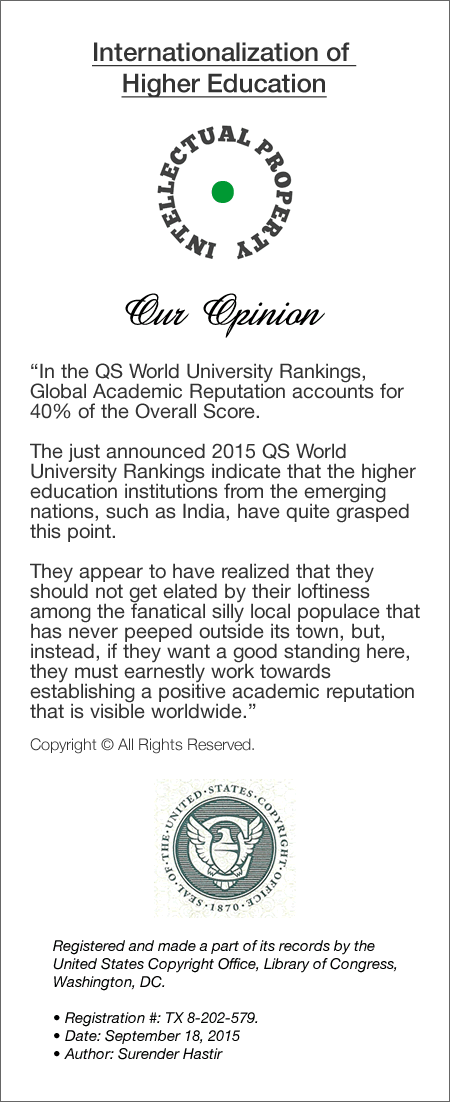







Edited & Posted by Editor | 2:58 AM | Link to this Post
December 1, 2015
QS World's Best Student Cities 2016
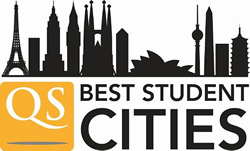

Photo: Dance Students in Paris, France. Image Credit & Copyright © Lieven Soete.
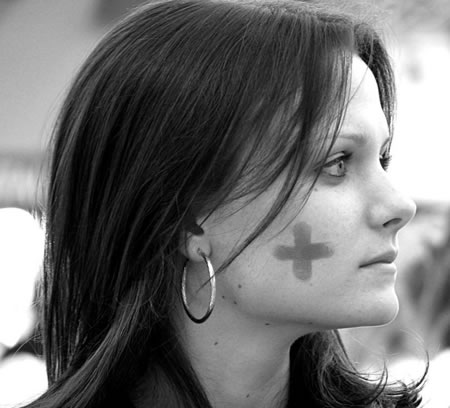
Photo: Nursing Student in Paris, France. Image Credit & Copyright © Manuel.
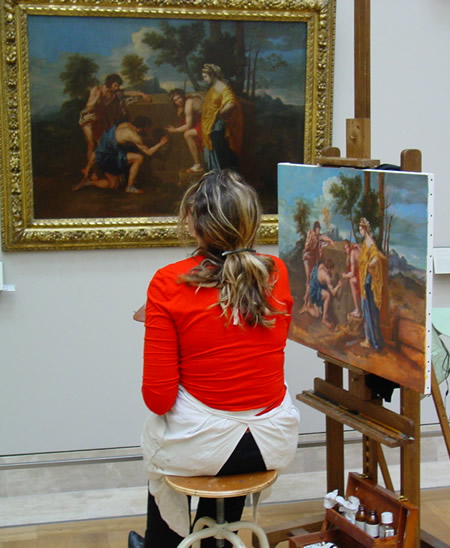
Photo: Art Student in Paris, France, copying an original work of art at the Louvre, one of the world’s largest museums. Image Credit & Copyright © Regan Wright.
LONDON, December 1, 2015 — Paris, the French capital, has again topped the QS Best Student Cities Rankings. It is followed by Melbourne, again second, and Tokyo in the third place.
London stands behind Sydney and ahead of Singapore, with the high cost of living in London being the primary reason it does not feature higher.
QS Best Student Cities 2016
- Paris, France
- Melbourne, Australia
- Tokyo, Japan
- Sydney, Australia
- London, United Kingdom
- Singapore, Singapore
- Montreal, Canada
- Hong Kong, Asia
- Berlin, Germany
- Seoul, South Korea
- Munich, Germany
- Zurich, Switzerland
- Toronto, Canada
- Vancouver, Canada
- Boston, Massachusetts, United States
- Vienna, Austria
- Canberra, Australia
- Auckland, New Zealand
- Brisbane, Australia
- New York, New York, United States
- Kyoto-Osaka-Kobe, Japan
- Madrid, Spain
- Taipei, Taiwan
- Stockholm, Sweden
- Beijing, China
- Adelaide, Australia
- Amsterdam, Netherlands
- San Francisco, California, United States
- Copenhagen, Denmark
- Barcelona, Spain
- Chicago, Illinois
- Buenos Aires , Argentina
- Edinburgh, United Kingdom
- Helsinki, Finland
- Perth, Australia
- Manchester, United Kingdom
- Dublin, Ireland
- Milan, Italy
- Shanghai, China
- Prague, Czech Republic
- Brussels, Belgium
- Los Angeles, United States
- Moscow, Russia
- Coventry, United Kingdom
- Washington DC, United States
- Lyon, France
- Christchurch, New Zealand
- Philadelphia, United States
- Santiago, Chile
- Mexico City, Mexico
- Ottawa, Canada
- Lisbon, Portugal
- Kuala Lumpur, Malaysia
- Gothenburg, Sweden
- Quebec , Canada
- Hsinchu, Taiwan
- Nottingham, United Kingdom
- Pittsburgh, United States
- Atlanta, United States
- Oslo, Norway
- Rome, Italy
- Daejeon, South Korea
- Sao Paulo, Brazil
- Glasgow, United Kingdom
- Warsaw, Poland
- Birmingham, United Kingdom
- Newcastle Upon Tyne, United Kingdom
- Sharjah, United Arab Emirates
- Gold Coast, Australia
- Valencia, Spain
- Baltimore, United States
- San Diego, United States
- Brno, Czech Republic
- Toulouse, France
- Monterrey, Mexico
Anne Hidalgo, Mayor of Paris, said: “Paris is proud to be ranked as the best world student city. Our youth reflect our greatest strength… We will continue to support students by offering them opportunities in an open, dynamic, and creative city.”
The United States is the most represented nation, with eleven placed cities. Boston (=13th) and New York (20th) are in the top twenty. It is followed by the United Kingdom (eight cities) and Australia (seven). The expanded rankings shine the spotlight on a series of new cities, such as Oslo and Monterrey.
The ranking are based on five key pillars:
- University Rankings
- Student Mix
- Quality of Living
- Employer Activity
- Affordability
To be included in the ranking, each city must have a population of over 2,50,000, and must be home to at least two ranked institutions in the QS World University Rankings. 122 cities in the world qualified on this basis, and 75 have been ranked.
The QS Best Student Cities rankings are designed to provide students and parents with a detailed comparison of the various merits of university cities worldwide.
|GlobalGiants.Com|







Edited & Posted by Editor | 4:27 AM | Link to this Post
November 12, 2015
Global Innovation Index 2015: Switzerland, UK, Sweden, Netherlands, USA are Leaders

Photo: World Intellectual Property Organization. WIPO Main Building and the Place des Nations in summer. © WIPO 2011. Photographer: Emmanuel Berrod.

Photo: World Intellectual Property Organization. WIPO Conference Hall. Foyer of the WIPO Conference Hall featuring volumes and perspectives created by ramps, staircases, railings, landings and mezzanines. The Conference Hall was inaugurated in September 2014. © WIPO 2014. Photographer: Emmanuel Berrod.

Photo: World Intellectual Property Organization. WIPO Director General Opens “Georgian Heritage” Exhibition at WIPO on the sidelines of the WIPO Assemblies, which met in Geneva from October 5 to 14, 2015. © WIPO 2015. Photographer: Emmanuel Berrod.
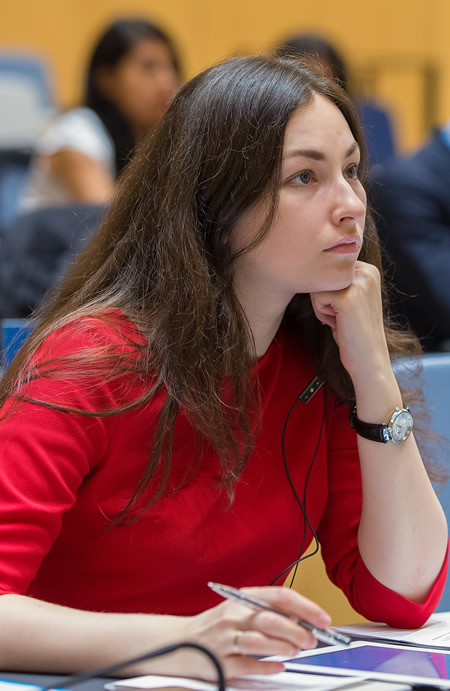
Photo: World Intellectual Property Organization. A Member of the Delegation from the Russian Federation attends the Committee on Development and Intellectual Property. The Sixteenth Session of WIPO’s Committee on Development and Intellectual Property (CDIP) is taking place in Geneva, Switzerland from November 9 to November 13, 2015. © WIPO 2015. Photographer: Emmanuel Berrod.
Switzerland, the United Kingdom, Sweden, the Netherlands and the United States of America are the world’s five most innovative nations, according to the Global Innovation Index 2015, while China, Malaysia, Viet Nam, India, Jordan, Kenya, and Uganda are among a group of countries outperforming their economic peers.
The GII (Global Innovation Index) 2015 looks at “Effective Innovation Policies for Development” and shows new ways that emerging-economy policymakers can boost innovation and spur growth by building on local strengths.
“Innovation holds far-reaching promise for spurring economic growth in countries at all stages of development. However, realizing this promise is not automatic,” said WIPO Director General Francis Gurry, “Each nation must find the right mix of policies to mobilize the innate innovative and creative potential in their economies.”
The GII, co-published by Cornell University, INSEAD and the World Intellectual Property Organization (WIPO), surveys 141 economies around the world, using 79 indicators to gauge both innovative capabilities and measurable results.
Top Rankings
- Switzerland
- United Kingdom
- Sweden
- Netherlands
- United States of America
- Finland
- Singapore
- Ireland
- Luxembourg
- Denmark
• In terms of innovation quality - as measured by university performance, the reach of scholarly articles and the international dimension of patent applications - a few economies stand out. The US and the UK stay ahead of the pack, largely as a result of their world-class universities, closely followed by Japan, Germany and Switzerland. Top-scoring middle-income economies on innovation quality are China, Brazil and India, with China increasingly outpacing the others.
Soumitra Dutta, Anne and Elmer Lindseth Dean, Samuel Curtis Johnson Graduate School of Management, Cornell University and co-author of the report, points out that “Innovation quality matters. Creating world class universities and investing in research is essential for staying ahead in the global race for successful innovation.”
Regional Innovation Leaders
Rank in Region — Country Name — GII 2015 Rank
Central and Southern Asia
- India — 81
- Kazakhstan — 82
- Sri Lanka — 85
Europe
- Switzerland — 1
- United Kingdom — 2
- Sweden — 3
Latin America and the Caribbean
- Chile — 42
- Costa Rica — 51
- Mexico — 57
Northern Africa and Western Asia
- Israel — 22
- Cyprus — 34
- Saudi Arabia — 43
Northern America
- United States of America — 5
- Canada — 16
Southeast Asia and Oceania
- Singapore — 7
- Hong Kong (China) — 11
- Korea, Rep. of — 14
Sub-Saharan Africa
- Mauritius — 49
- South Africa — 60
- Senegal — 84
The Global Innovation Index 2015 (GII), in its 8th edition this year, is co-published by Cornell University, INSEAD, and the World Intellectual Property Organization (WIPO), a specialized agency of the United Nations.
Published annually since 2007, the GII is now a leading benchmarking tool for business executives, policy makers and others seeking insight into the state of innovation around the world.
|GlobalGiants.Com|
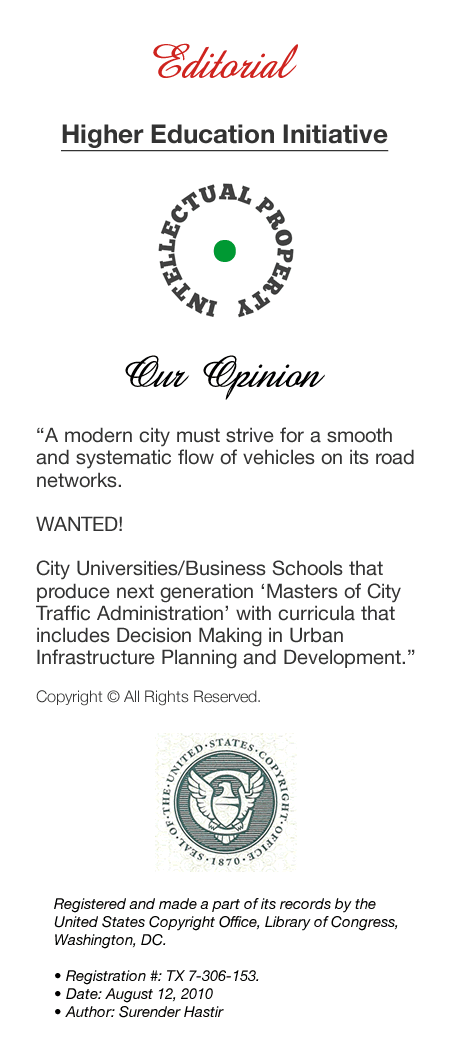







Edited & Posted by Editor | 1:10 PM | Link to this Post
November 6, 2015
India aspiring to have a World Class University
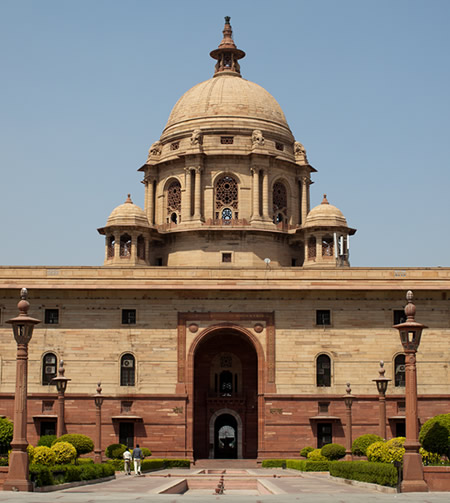
Photo: Entrance to Rashtrapati Bhavan (Presidential Palace), New Delhi, India. Picture Credit: Rob Towell.
New Delhi, India — November 6, 2015 — India’s first ever Visitor’s Conference concluded today at Rashtrapati Bhavan (Presidential Palace) with an interactive session between Industry and Academia. The President of India is Visitor of 114 central institutions of higher learning.
Participants in the conference included heads of all Central Universities and Indian Institutes of Technology’s.
During the conference, India’s Prime Minister, Narendra Modi, released a brochure “IMPRINT INDIA” and handed over the first copy to the President of India. Smriti Irani, India’s Human Resource Development Minister, was also present on the occasion.
• The President of India, Pranab Mukherjee said, “my constant refrain that we cannot aspire to be a world power without having a single world-class university, has found resonance amongst the institutions, who have now started looking at the international ranking processes in a more proactive and systematic manner.”
“For the first time,” President Mukherjee said, “two Indian institutions have found place in the top 200 positions in QS rankings.” “Indian Institute of Science Bangalore at 147th and Indian Institute of Technology Delhi at 179th place deserve full praise and compliments,” he added.
“Innovation is the currency of the future. Innovation converts research into wealth,” the President concluded. “Unless we recognize this reality and start working in a focused manner on creating a strong innovation culture in our country now, we will be left behind in the march to modernity.”
Source: President’s Secretariat, Rashtrapati Bhavan
|GlobalGiants.Com|







Edited & Posted by Editor | 7:33 AM | Link to this Post
November 5, 2015
Global Education Community adopts and launches Education 2030 Framework for Action

Photo: Secretary-General Ban Ki-moon (right) and Gordon Brown (left), United Nations Special Envoy for Global Education, with an education youth ambassador at the Oslo Summit on Education for Development. 07 July 2015. Oslo, Norway. UN Photo/Rick Bajornas.
UNESCO Headquarters, Paris, France - November 4, 2015 - “Today, with the Education 2030 Framework for Action, Governments from across the world have agreed on how to translate a promise on paper to change on the ground,” said UNESCO Director-General Irina Bokova at the launch event.
• The Education 2030 Framework for Action was adopted by more than 70 Ministers, representatives of Member States, the United Nations, multilateral and bi-lateral agencies, civil society, regional organizations, the teaching profession, academia, youth, and the private sector.
Ministers and Heads of Delegation took the floor throughout a day-long meeting, which ended with closing addresses by Kishore Singh, Special Rapporteur on the Right to Education, and the Prime Minister of Cook Islands, Mr Henry Puna.
• The FFA, the result of an unprecedented consultative process, provides guidance to countries for the implementation of the Education 2030 agenda. It aims to mobilize all stakeholders around the new global education goal and targets, and proposes ways of implementing, coordinating, financing and reviewing the 2030 education agenda—globally, regionally and nationally—to guarantee equal educational opportunity for all.
“Never before has the world consulted in such depth on a new goal in education, bringing all voices to the table. Never before has the world agreed on such a detailed road-map for the implementation of a new goal,” said the UNESCO Director-General.
The Declaration entrusts UNESCO, the United Nations’ specialized agency for education, to continue its mandated role and lead and coordinate Education 2030.
|GlobalGiants.Com|

“Educating the mind without educating the heart is no education at all.”
— Aristotle.







Edited & Posted by Editor | 8:23 AM | Link to this Post
October 7, 2015
The L’Oreal Foundation and UNESCO Reveal the Laureates of the 2016 L’Oreal-UNESCO For Women In Science Awards
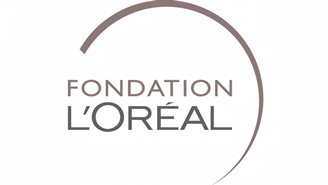

Photo: Doctor Vanessa D’Costa. Immunogenetics of Infectious Diseases. International Rising Talent 2015, North America (Canada). Image © Stephane Cardinale / People Avenue. Copyright © All rights reserved by L’Oreal-UNESCO For Women in Science.
Paris - The L’Oréal Foundation and UNESCO today revealed the five winners of the 2016 L’Oreal-UNESCO For Women in Science Awards in the field of Life Sciences. They will receive their awards at a ceremony to be held on 24 March 2016 in Paris.
Nominated by more than 2,600 leading scientists, 2016’s five laureates were then selected by an independent and international jury of 13 prominent scientists in the international scientific community. This year’s President of the Jury is Professor Elizabeth H. Blackburn, 2008 Laureate L’Oreal-UNESCO For Women in Science and 2009 joint winner of the Nobel Prize in Physiology or Medicine.
The jury announced the winners of the 2016 edition, five women scientists who will be awarded on 24 March 2016 at the Grand Amphitheatre of the Sorbonne in Paris. Each laureate will receive a Prize of €100,000 in recognition of her contribution to science.
THE LAUREATES
EUROPE
Professor Emmanuelle CHARPENTIER
Director, Max Planck Institute for Infection Biology, Berlin, Germany.
- Biological Sciences/Molecular Biology.
NORTH AMERICA
Professor Jennifer DOUDNA
Professor, Howard Hughes Medical Institute, Department of Molecular and Cell Biology, University of California, Berkeley, United States of America.
- Biological Sciences/Molecular Biology.
AFRICA AND THE ARAB STATES
Professor Quarraisha ABDOOL KARIM
Professor, CAPRISA, Nelson R Mandela School of Medicine, University of KwaZulu- Natal, South Africa.
- Medicine and Health Sciences/Women’s Health.
ASIA/PACIFIC
Professor Hualan CHEN
Professor, Harbin Veterinary Research Institute, Chinese Academy of Agricultural Sciences, Harbin, China.
- Biological Sciences/Veterinary Sciences.
LATIN AMERICA
Professor Andrea GAMARNIK
Professor, Molecular Virology Laboratory, Fundacion Instituto Leloir, CONICET, Buenos Aires, Argentina.
- Biological Sciences/Virology.
|GlobalGiants.Com|







Edited & Posted by Editor | 7:53 AM | Link to this Post
October 6, 2015
U.S. News & World Report Unveils Second Annual Best Global Universities Rankings

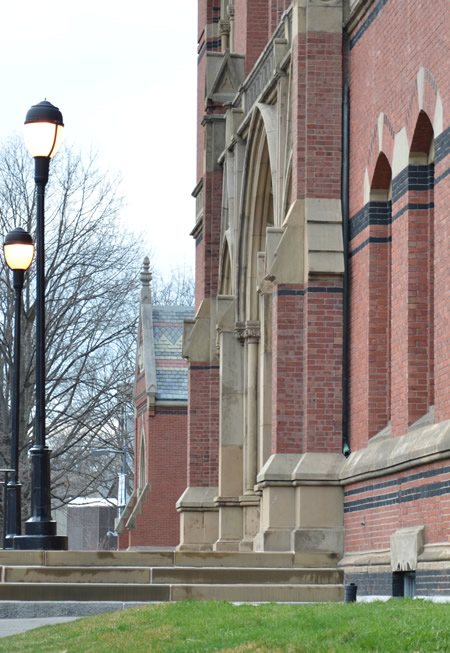
Photo: Entrance to the Memorial Hall, Harvard University. Photo Credit: Photographer © Michael Kappel.
WASHINGTON, D.C., Oct. 6, 2015 — U.S. News & World Report, publisher of Best Colleges for more than 30 years, today released the 2016 edition of the Best Global Universities. The rankings help students evaluate higher education options worldwide as well as by region, country and subject. U.S. universities remain the global leaders among research institutions, with Harvard University claiming No. 1, followed by the Massachusetts Institute of Technology at No. 2, the University of California—Berkeley at No. 3 and Stanford University at No. 4. U.K. universities take the next top spots with the University of Oxford at No. 5, followed by the University of Cambridge at No. 6.
The following countries have the most ranked institutions out of 750 schools on the overall Best Global Universities list:
- United States: 181
- China: 57
- United Kingdom: 55
- Germany: 50
- Italy: 38
“Students are increasingly looking outside their own countries for educational opportunities,” said Anita Narayan, managing editor of Education at U.S. News. “As international education continues to evolve, U.S. News will be at the forefront of the conversation - providing comparable information across global institutions and presenting it in bite-sized pieces for students and their families, just as we have done for three decades in the U.S.”
The second edition of the Best Global Universities rankings are more comprehensive, including rankings of the top 750 universities - up from 500 last year - spread out across 57 countries. U.S. News has published new university rankings of larger countries including India and Brazil, and smaller countries such as Belgium, bringing the total number of country-specific rankings up to 32. The 2016 edition also debuts a regional ranking for Africa, adding to the previous four regional rankings, and features a new subject ranking for arts and humanities, bringing up the total to 22 subject rankings.
These countries, listed in rank order, performed best in the following subject rankings:
- Arts and humanities: U.S., U.K., Netherlands (tie), Australia (tie), Germany
- Clinical medicine: U.S., Germany, U.K., Italy, Canada
- Computer science: U.S., China, U.K., Canada (tie), Hong Kong (tie), Australia (tie)
- Economics and business: U.S., U.K., Canada (tie), Netherlands (tie), Australia (tie)
- Engineering: U.S., China, U.K., Canada, Australia
The Best Global Universities methodology - which is based on data and metrics provided by Thomson Reuters InCitesTM research analytics solutions - weighs factors that measure a university’s global and regional reputation; academic research performance using bibliometric indicators; and school-level data on faculty and Ph.D. graduates. Each subject ranking has its own, similar methodology.
“We have designed the rankings to be a starting point to help students and their families identify institutions that speak to their specific needs, whether they are planning on staying close to home or traveling abroad for college - or whether they are seeking a specific academic degree,” said Robert Morse, chief data strategist at U.S. News.
U.S. News 2016 Best Global Universities Rankings
Overall Best Global Universities
- Harvard University (U.S.)
- Massachusetts Institute of Technology (U.S.)
- University of California—Berkley (U.S.)
- Stanford University (U.S.)
- University of Oxford (U.K.)
- University of Cambridge (U.K.)
- California Institute of Technology (U.S.)
- University of California—Los Angeles (U.S.)
- Columbia University (U.S.)
- University of Chicago (U.S.)
Africa
- University of Cape Town (South Africa)
- University of Witwatersrand (South Africa)
- Stellenbosch University (South Africa)
- University of KwaZulu-Natal (South Africa)
- Cairo University (Egypt)
Asia
- University of Tokyo (Japan)
- Peking University (China)
- National University of Singapore
- Tsinghua University (China)
- University of Hong Kong
Australia/New Zealand
- University of Melbourne (Australia)
- University of Sydney
- University of Queensland Australia
- Australian National University
- Monash University (Australia)
Europe
- University of Oxford (U.K.)
- University of Cambridge (U.K.)
- Imperial College London
- University College London
- Swiss Federal Institute of Technology Zurich (Switzerland)
Latin America
- Universidade de São Paulo (Brazil)
- Universidade Federal do Rio de Janeiro (Brazil)
- Universidade Estadual de Campinas (Brazil)
- University of Buenos Aires (Argentina)
- National Autonomous University of Mexico
Country Specific
India
- Indian Institute of Science, Bangalore
- Panjab University, Chandigarh
- Indian Institute of Technology, Bombay
- Indian Institute of Technology, Delhi
- Indian Institute of Technology, Madras
- Aligarh Muslim University, Aligarh
- Indian Institute of Technology, Kanpur
- Indian Institute of Technology, Kharagpur
- University of Delhi, New Delhi
- Banaras Hindu University, Varanasi
- Jadavpur University, Kolkata
- Indian Institute of Technology, Roorkee
- University of Hyderabad, Hyderabad
- All India Institute of Medical Sciences, New Delhi
|GlobalGiants.Com|







Edited & Posted by Editor | 1:54 PM | Link to this Post
September 30, 2015
Times Higher Education Announces its World University Rankings 2015-2016
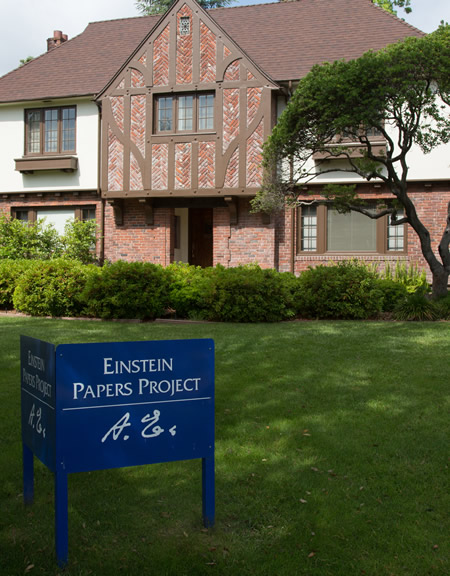
Photo: A house situated inside the California Institute of Technology Campus. Image Credit: Jim Fruchterman.
According to Times Higher Education, the world dominance of U.S. universities has further waned in its World University Rankings 2015-2016 announced today. This is despite the fact that the country boasts almost a fifth of institutions in the table.
A total of 147 US universities feature in the top 800 - the largest THE rankings to date - including the California Institute of Technology, which claims pole position for the fifth consecutive year.
Phil Baty, THE rankings editor, said that the US’ movement is to some degree owing to significant improvements to the rankings’ data sources this year, with “improved coverage of research not published in English and a better geographical spread of responses to our academic reputation survey”.
However, he added that it also demonstrates that the US’ leading status as the world’s top magnet for academic and student talent “cannot be taken for granted”, citing figures that show that 47 states in the US have implemented higher education funding cuts since the global recession in 2008.
Simon Marginson, professor of international higher education at the UCL Institute of Education, said that US research is “not declining in the absolute sense”, but rather “other countries are improving and crowding into the top 200 space”.
One of these competitor nations is the UK, which has improved its standing this year. A total of 78 UK institutions feature in the top 800, with 34 of these sitting in the first quarter, up from 29 last year.
Other countries in Europe have also performed well. Germany has 20 universities in the top 200, a rise of eight since last year, while the Netherlands has 12 in the first quarter, up from 11. Meanwhile, Switzerland’s ETH Zurich is the first non-Anglo-American institution to make the top 10 for a decade.
Overall, Europe has 345 universities in the world top 800, meaning its institutions comprise more than two-fifths of the table.
Institutions from 70 countries, 29 more than last year, feature in this year’s rankings, with several countries including Indonesia, Bangladesh and Kenya being represented for the first time.
The National University of Singapore is the number one institution in Asia - the first time the city-state has claimed the continent’s top spot in the rankings’ 12-year history.
NUS is in 26th position overall in the rankings, with the next highest Asian institutions - China’s Peking University and Japan’s University of Tokyo - taking 42nd and 43rd place respectively.
“Tough times for Japan and disappointment for South Korea mean that leading Asian nations’ grip on the higher ranks of the THE World University Rankings is loose,” said Phil Baty, THE rankings editor.
“Many institutions, particularly in East Asia, have been focusing heavily on attaining world-class status, backed with funding and powerful political will. But this ranking demonstrates how difficult a task this is, as universities right across the world continue to improve.”
TIMES HIGHER EDUCATION WORLD UNIVERSITY RANKINGS 2015-2016: TOP 10
RANK — INSTITUTION — COUNTRY
- California Institute of Technology — United States
- University of Oxford — United Kingdom
- Stanford University — United Kingdom
- University of Cambridge — United Kingdom
- Massachusetts Institute of Technology — United States
- Harvard University — United States
- Princeton University — United States
- Imperial College London — United Kingdom
- ETH Zurich — Switzerland
- University of Chicago — United States
TIMES HIGHER EDUCATION WORLD UNIVERSITY RANKINGS 2015-2016: INSTITUTIONS FROM INDIA
RANK — INSTITUTION
- 251-300 — Indian Institute of Science
- 351-400 — Indian Institute of Technology Bombay
- 401-500 — Indian Institute of Technology Delhi
- 401-500 — Indian Institute of Technology Kharagpur
- 401-500 — Indian Institute of Technology Madras
- 501-600 — Indian Institute of Technology Guwahati
- 501-600 — Indian Institute of Technology Kanpur
- 501-600 — Indian INstitute of Technology Roorkee
- 501-600 — Jadavpur University
- 501-600 — Panjab University Chandigarh
- 601-800 — Aligarh Muslim University
- 601-800 — Amrita University
- 601-800 — Andhra University
- 601-800 — Birla Institute of Technology and Science, Pilani
- 601-800 — University of Calcutta
- 601-800 — University of Delhi
- 601-800 — Savitribai Phule Pune University
|GlobalGiants.Com|







Edited & Posted by Editor | 5:51 PM | Link to this Post
September 18, 2015
MEDALISTS UNVEILED AT THE 2015 STUDENT ACADEMY AWARDS

Photo: Actress Michelle Rodriguez prior to the 42nd Annual Student Academy Awards on Thursday, September 17, in Beverly Hills. Image Credit: Matt Petit / © Academy of Motion Picture Arts and Sciences.

Photo: Animated film winners Nicholas Manfredi (left) and Elizabeth Ku-Herrero prior to the 42nd Annual Student Academy Awards on Thursday, September 17, in Beverly Hills. Image Credit: Matt Petit / © Academy of Motion Picture Arts and Sciences.
LOS ANGELES, CA - Thursday, September 17, 2015 — The Academy of Motion Picture Arts and Sciences tonight honored 15 student winners from colleges and universities around the world at the 42nd Student Academy Awards ceremony, held at the Samuel Goldwyn Theater in Beverly Hills. The Gold, Silver and Bronze Medal awards were announced and presented by actors Michelle Rodriguez and Jason Mitchell, Oscar-winning director John Lasseter, and the Oscar-winning team behind the animated feature “Big Hero 6,” Roy Conli, Don Hall and Chris Williams.
The 2015 Student Academy Award winners are:
Alternative
- Gold: “Chiaroscuro,” Daniel Drummond, Chapman University, California
- Silver: “Zoe,” ChiHyun Lee, The School of Visual Arts, New York
Animation
- Gold: “Soar,” Alyce Tzue, Academy of Art University, San Francisco
- Silver: “An Object at Rest,” Seth Boyden, California Institute of the Arts
- Bronze: “Taking the Plunge,” Nicholas Manfredi and Elizabeth Ku-Herrero, The School of Visual Arts
Documentary
- Gold: “Looking at the Stars,” Alexandre Peralta, University of Southern California
- Silver: “I Married My Family’s Killer,” Emily Kassie, Brown University
- Bronze: “Boxeadora,” Meg Smaker, Stanford University
Narrative
- Gold: “Day One,” Henry Hughes, American Film Institute, California
- Silver: “This Way Up,” Jeremy Cloe, American Film Institute
- Bronze: “Stealth,” Bennett Lasseter, American Film Institute
Foreign Film
- Gold: “Fidelity,” Ilker Catak, Hamburg Media School, Germany
- Silver: “The Last Will,” Dustin Loose, Filmakademie Baden-Wuerttemberg, Germany
- Bronze: “Everything Will Be Okay” Patrick Vollrath, Filmakademie Wien, Austria
The Student Academy Awards were established in 1972 to provide a platform for emerging global talent by creating opportunities within the industry to showcase their work. Past Student Academy Award winners have gone on to receive 47 Oscar nominations and have won or shared eight awards.
|GlobalGiants.Com|







Edited & Posted by Editor | 7:55 AM | Link to this Post
September 15, 2015
QS World University Rankings 2015/16 Announced


Photo: M.I.T. (Massachusetts Institute of Technology) Campus, Cambridge, Massachusetts, USA. Image Credit: Taaalia.
LONDON — The QS World University Rankings 2015/16 announced today confirm Massachusetts Institute of Technology (MIT) as the world’s top university followed by Harvard (2nd), Cambridge and Stanford (3rd=), while ETH Zurich (9th) breaks into the top 10.
Singapore’s leading universities gain substantially, each making the top 15 for the first time. National University of Singapore (12th) is the leading Asian institution and Nanyang Technological University (13th) is right behind them, taking a quantum leap.
Australian National University (19th) also returns to the top 20. China’s Tsinghua University (25th) is Asia’s third best university, leading a strong Chinese cohort.
76,798 academics and 44,226 employers contributed to the rankings through the QS global surveys, the largest of their kind and QS analyzed 11.1 million research papers - indexed by Elsevier’s Scopus database. 3,539 institutions were considered for inclusion and 891 ranked.
A modified approach to “citations per faculty”, a measure of research impact, has delivered fairer evaluations for universities with a strong profile in areas with lower research activity, such as arts, humanities and social sciences. LSE (35th) and other leading institutions traditionally overshadowed by research-intensive universities, see their excellence more equitably recognized.
Ben Sowter, QS head of research says: “These latest results reveal more diversity than ever in the distribution of world-class universities at the highest levels. We’re providing prospective students with the richest picture yet.”
QS WORLD UNIVERSITY RANKINGS 2015/2016 — TOP TWENTY
RANK — INSTITUTION — COUNTRY
- 01 — MASSACHUSETTS INSTITUTE OF TECHNOLOGY (MIT) — US
- 02 — HARVARD UNIVERSITY — US
- 03= — UNIVERSITY OF CAMBRIDGE — UK
- 03= — STANFORD UNIVERSITY — US
- 05 — CALIFORNIA INSTITUTE OF TECHNOLOGY (CALTECH) — US
- 06 — UNIVERSITY OF OXFORD — UK
- 07 — UNIVERSITY COLLEGE LONDON — UK
- 08 — IMPERIAL COLLEGE LONDON — UK
- 09 — ETH ZURICH — CH
- 10 — UNIVERSITY OF CHICAGO — US
- 11 — PRINCETON UNIVERSITY — US
- 12 — NATIONAL UNIVERSITY SINGAPORE — SG
- 13 — NANYANG TECHNOLOGICAL UNIVERSITY — SG
- 14 — EPFL — CH
- 15 — YALE UNIVERSITY — US
- 16 — JOHNS HOPKINS UNIVERSITY — US
- 17 — CORNELL UNIVERSITY — US
- 18 — UNIVERSITY OF PENNSYLVANIA — US
- 19= — AUSTRALIAN NATIONAL UNIVERSITY — AU
- 19= — KING’S COLLEGE LONDON — UK
The rankings include universities from 82 countries. Thirty-four countries feature in the Top 200. The United States dominates with 49 institutions, ahead of the UK (30), Netherlands (12), Germany (11), Canada, Australia, and Japan (8), China (7), France, Sweden and Hong Kong (5).
Following institutions from India have found a place among the top 800:
RANK — OVERALL SCORE — INSTITUTION
- 147 — 62.0 — Indian Institute of Science (IISc) Bangalore
- 179 — 56.4 — Indian Institute of Technology Delhi (IITD)
- 202 — 52.8 — Indian Institute of Technology Bombay (IITB)
- 254 — 46.6 — Indian Institute of Technology Madras (IITM)
- 271 — 45.0 — Indian Institute of Technology Kanpur (IITK)
- 286 — 43.7 — Indian Institute of Technology, Kharagpur
- 391 — 35.7 — Indian Institute of Technology Roorkee (IITR)
RANK — INSTITUTION
- 451-460 — Indian Institute of Technology Guwahati (IITG)
- 481-490 — University of Delhi
- 601-650 — University of Calcutta
- 701+ — Banaras Hindu University
- 701+ — Panjab University, Chandigarh
- 701+ — University of Mumbai
- 701+ — University of Pune
- NA — Jawaharlal Nehru University
Meanwhile, the President of India, Pranab Mukherjee, has congratulated the Indian Institute of Science-Bangalore (IISc-B) and the Indian Institute of Technology-Delhi (IIT-D) for figuring in the list of top 200 institutions of the QS World University Rankings.
“A high rank not only boosts the morale of the academic community but also opens greater avenues of growth and placement for students,” the president said. View the Official Press Release.
|GlobalGiants.Com|

“In the QS World University Rankings, Global Academic Reputation accounts for 40% of the Overall Score.
The just announced 2015 QS World University Rankings indicate that the higher education institutions from the emerging nations, such as India, have quite grasped this point.
They appear to have realized that they should not get elated by their loftiness among the fanatical silly local populace that has never peeped outside its town, but, instead, if they want a good standing here, they must earnestly work towards establishing a positive academic reputation that is visible worldwide.”
© GlobalGiants.Com







Edited & Posted by Editor | 9:23 AM | Link to this Post
September 9, 2015
U.S. News & World Report Announces the 2016 Best Colleges in the USA


Photo: Princeton University Campus. Image provided by & copyright © Princeton University Office of Communications.
WASHINGTON, Sept. 9, 2015 — U.S. News & World Report today released the 2016 edition of Best Colleges to help domestic and international students compare the academic quality of U.S.-based schools. The new edition includes data on nearly 1,800 colleges and features rankings of 1,376 schools.
• Princeton University remains No. 1 in the Best National Universities category, while Williams College once again tops the Best National Liberal Arts Colleges list. The University of California—Berkeley is the No. 1 Top Public School among National Universities.
The U.S. News rankings focus on academic excellence, with schools ranked on up to 16 measures of academic quality. The rankings emphasize outcomes, with graduation and retention rates carrying the most weight in the methodology at 30 percent. The top schools all have high six-year graduation rates and strong freshman retention rates:
“Taking into account how well a school supports its students from freshman year through graduation is important,” said Brian Kelly, editor and chief content officer at U.S. News. “To find the best fit, students should consider a range of factors, from financial aid offerings and location to campus size and majors. The process can be overwhelming, but our rankings and advice content are a great place to start.”
The 2016 edition debuts a Most Innovative Schools list, featuring institutions making inventive improvements in terms of campus life, curriculum, facilities, faculty, students or technology.
“We are the only organization that has been ranking schools for over three decades,” said Robert Morse, chief data strategist at U.S. News. “Over that time we have improved our information and sharpened our methodology’s focus, with one of the biggest updates being a greater consideration of output measurements.”
The college ranking categories are based upon the 2010 Carnegie Foundation for the Advancement of Teaching classifications. The Carnegie classification system has been used by U.S. News since the first Best Colleges rankings in 1983, because they are accepted as the basis for classifying schools by most higher education researchers.
U.S. News 2016 Best Colleges Rankings
Best National Universities — Top Ten
- Princeton University (NJ)
- Harvard University (MA)
- Yale University (CT)
- Columbia University (NY)
- Stanford University (CA)
- University of Chicago (IL)
- Massachusetts Institute of Technology
- Duke University (NC)
- University of Pennsylvania
- California Institute of Technology
- Johns Hopkins University (MD)
Best National Liberal Arts Colleges — Top Ten
- Williams College (MA)
- Amherst College (MA)
- Swarthmore College (PA)
- Bowdoin College (ME)
- Middlebury College (VT)
- Pomona College (CA)
- Wellesley College (MA)
- Carleton College (MN)
- Claremont McKenna College (CA)
- Davidson College (NC)
- United States Naval Academy (MD)
Top Public Schools
National Universities — Top Five
- University of California—Berkeley
- University of California—Los Angeles
- University of Virginia
- University of Michigan—Ann Arbor
- University of North Carolina—Chapel Hill
Liberal Arts Colleges — Top Five
- United States Naval Academy (MD)
- United States Military Academy (NY)
- United States Air Force Academy (CO)
- New College of Florida
- Virginia Military Institute
|GlobalGiants.Com|







Edited & Posted by Editor | 8:46 AM | Link to this Post
August 4, 2015
World Leaders to Formally Adopt the Post-2015 Development Agenda in September

Photo: David Donoghue, Permanent Representative of Ireland to the UN, addresses a press conference on the agreement achieved on 2 August by Member States on the outcome document of the United Nations Summit to adopt the post-2015 development agenda to be held in New York from 25 to 27 September 2015. Mr. Donoghue, along with Macharia Kamau, Permanent Representative of the Republic of Kenya, co-facilitated the negotiations leading to the agreement on the document. 03 August 2015. United Nations, New York. UN Photo/Mark Garten.

Photo: UN Secretary-General Ban Ki-moon (right) meets with Barack Obama, President of the United States, in the Oval Office in Washington, D.C. 04 August 2015. Washington, DC, United States. UN Photo/Mark Garten.
• The 193 Member States of the United Nations reached agreement today on the outcome document that will constitute the new sustainable development agenda that will be adopted this September by world leaders at the Sustainable Development Summit in New York.
Concluding a negotiating process that has spanned more than two years and has featured the unprecedented participation of civil society, countries agreed to an ambitious agenda that features 17 new sustainable development goals that aim to end poverty, promote prosperity and people’s well-being while protecting the environment by 2030.
More than 150 world leaders are expected to attend the Sustainable Development Summit at the UN headquarters in New York between 25 to 27 September to formally adopt the outcome document of the new sustainable agenda.
The preamble of the 29-page text, “Transforming Our World: The 2030 Agenda for Sustainable Development,” states, “We are resolved to free the human race from the tyranny of poverty and want and to heal and secure our planet.” It continues, “We are determined to take the bold and transformative steps which are urgently needed to shift the world onto a sustainable and resilient path. As we embark on this collective journey, we pledge that no one will be left behind.”
|GlobalGiants.Com|







Edited & Posted by Editor | 9:01 AM | Link to this Post
July 23, 2015
IBM Partners with 200 Universities Globally to Train Next-Generation of Cloud Developers

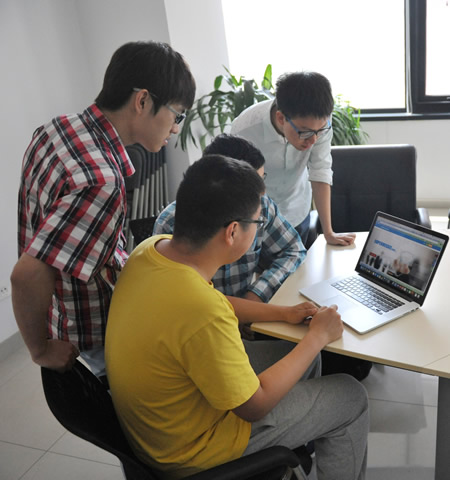
Photo: Students from Tsinghua University (Beijing, China) are using the IBM-developed SuperVessel cloud service to develop cloud and emerging technology applications. These students are part of a growing community of developers contributing to the OpenPOWER ecosystem worldwide. (Credit: IBM).

Photo: Project managers in IBM’s Costa Rica Delivery Center talk with global clients about implementing solutions in the areas of cloud, security, data storage and analytics to optimize their IT infrastructure. Forrester Research named IBM the leading supplier in global infrastructure outsourcing, based on a survey of 13 top firms, noting IBM’s vision for cloud and the rise of hybrid cloud as a priority for clients. (Credit: IBM).
ARMONK, N.Y - 22 Jul 2015: IBM is introducing a new commitment to enable the next generation of developers with the Academic Initiative for Cloud, aimed to mentor and energize them to innovate using IBM Cloud technologies. The new program will create cloud development curricula using Bluemix, IBM’s platform-as-a-service, in over 200 universities, reaching more than 20,000 students in 36 countries.
“Putting Bluemix in the hands of today’s and tomorrow’s innovators creates the opportunity to foster a new generation of talent in cloud application development,” said IBM General Manager for Cloud Ecosystem and Developers, Sandy Carter. “Our commitment to provide deep cloud expertise to programs aimed at future cloud developers from academics to professionals is necessary to sustain the growth our industry forecasts.”
• Introducing the Academic Initiative for Cloud
IBM’s new Academic Initiative for Cloud will introduce students to the latest cloud technologies and solutions as they build the transferrable skills needed to launch their own businesses or become industry leaders in the workforce. This new program continues IBM’s leadership and commitment to closing the skills gap between higher education curricula and workforce needs, which already includes Big Data Analytics and Cognitive Computing academic programs.
Starting this fall, universities around the world will commence more than 250 courses and programs that will utilize educational materials, technologies and methodologies from IBM with a focus on using Bluemix in a variety of courses ranging from computer science, information technology, analytics and data science to mobile and entrepreneurship. The list of over 210 marquee institutions includes:
- Ben-Gurion University (Israel)
- Carnegie Mellon University
- Imperial College of Science (England)
- International Institute of Information Technology (India)
- National College of Ireland
- National University of Singapore
- Northwestern University
- University of California Irvine
- University of Cambridge
- University of Southern California
- University of Stuttgart
- University of Tokyo
The use of Bluemix in the classroom will allow faculty to extend their teaching beyond theory and into practice.
“Leaders in business and higher education must come together to foster a new generation of digital-savvy talent,” said Kevin Werbach, a professor and expert on gamification at the Wharton School of the University of Pennsylvania. “It’s great that IBM is so committed to connecting with top universities like ours, and to giving students and faculty exposure to the latest cloud technologies and business concepts. This experience will help prepare our students as they enter the marketplace.”
Additionally, IBM is launching a new Student Developer Community that helps students get started on their journey of cloud education, and provides quick access to learning resources and information on how students can join Bluemix U, where students can showcase their accomplishments and the impact of their real-world projects.
• Supporting Girls Who Code and ReBoot Accelerator to Diversify the Tech Talent Pipeline
Diversity drives innovation. With only 14% of computer science graduates being women today, down from 37% in 1984, IBM is committed to innovation-driven cloud development by supporting programs that empower women in technology and address the lack of women in technology professions.
As such, IBM is working with Girls Who Code to introduce the next generation of women developers to cloud innovation by hosting a class of female high-school students in New York City for a seven-week summer immersion program. For 2016, IBM has committed to further expand its relationship with the organization to support additional programs in San Francisco, Los Angeles and Austin, alongside continued support for the New York City summer immersion program.
IBM is also announcing a new collaboration with GSVlabs on the ReBoot Accelerator for Women, a program designed to help women become current, connected, and confident as they return to work after a multi-year sabbatical. IBM will host several instructional sessions that will focus on cloud development using Bluemix, aimed at demystifying coding and making it more approachable. IBM will also be providing mentorship and assistance with job placement strategies in hopes of attracting more women back to the workplace, including at IBM.
IBM is also working to create programs for developers to help them transform industry and enterprise.
|GlobalGiants.Com|
“The value of an idea lies in the using of it.”
— Thomas A. Edison.
“When I have fully decided that a result is worth getting I go ahead of it and make trial after trial until it comes.”
— Thomas A. Edison.
“I never did anything by accident, nor did any of my inventions come by accident; they came by work.”
— Thomas A. Edison.







Edited & Posted by Editor | 5:20 AM | Link to this Post
July 22, 2015
Conakry named World Book Capital for 2017

Photo: World Book Fair 2006, New Delhi, India. Image Credit © Maruthu Pandian.
Conakry, the capital of the Republic of Guinea, West Africa, has been named World Book Capital for 2017. The decision was made by an international committee of experts during a meeting at UNESCO’s Headquarters in Paris.
The selection committee singled out Conakry “on account of the quality and diversity of its programme, in particular its focus on community involvement” as well as “for its well-structured budget and clear development goals with a strong emphasis on youth and literacy”.
While welcoming the quality of all applications received by UNESCO for the title of World Book Capital 2017, the Director-General of UNESCO, Irina Bokova, endorsed the Committee’s decision to designate Conakry World Book Capital for 2017.
In congratulating Conakry, the Director-General said, “Books, learning and reading are key to human life. The strong investment of the Republic of Guinea in promoting books and literacy bears witness to a clear vision of culture and education as drivers of development and recovery, and UNESCO is determined to support these efforts.”
The World Book Capital is selected every year by the international organizations that represent the three major sectors of the book industry: the International Publishers Association (IPA), the International Booksellers Federation (IBF), and the International Federation of Library Associations and Institutions (IFLA). The year starts on 23 April, World Book and Copyright Day, and brings together the city’s publishers, writers and book industry to promote and celebrate books and reading over the next 12 months.
Conakry is the 17th city to be designated World Book Capital, after Madrid (2001), Alexandria (2002), New Delhi (2003), Antwerp (2004), Montreal (2005), Turin (2006), Bogota (2007), Amsterdam (2008), Beirut (2009), Ljubljana (2010), Buenos Aires (2011), Yerevan (2012), Bangkok (2013), Port Harcourt (2014) Incheon (2015) and Wroclaw (2016).
|GlobalGiants.Com|
“Never lend books, for no one ever returns them; the only books I have in my library are books that other folks have lent me.”
— Anatole France.







Edited & Posted by Editor | 9:41 AM | Link to this Post
July 8, 2015
China Dominates QS University Rankings: BRICS 2015

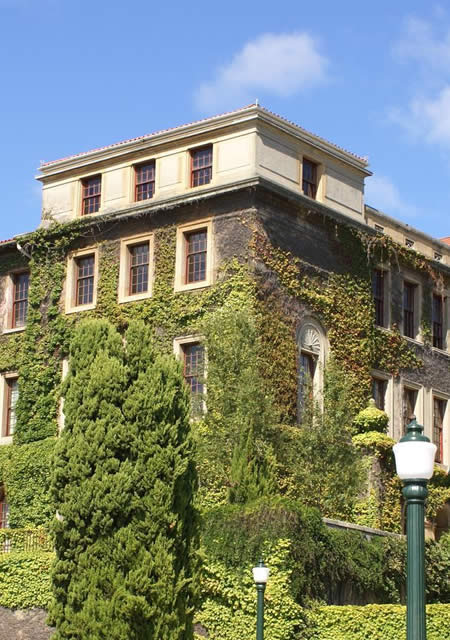
Photo: An ivy-covered building at the University of Cape Town (UCT), South Africa. UCT was established in 1829. Image credit © Danie van der Merwe.
The QS University Rankings: BRICS compares the Top 200 institutions in Brazil, Russia, India, China and South Africa.
Released today, the 2015 edition of the QS University Rankings: BRICS reflects the increasingly strong global presence of leading Chinese universities - with the top three spots going to Tsinghua University, Peking University and Fudan University.
While all five BRICS countries are represented within the top 20, China’s dominance is clear throughout the ranking. Driven by strong performance in the two global reputation surveys of academics and employers, Chinese universities take seven of the top 10 spots and almost half of the top 50. With 53 institutions in the top 200, Russia is second only to China, which has 67 universities featured. Yet only seven Russian institutions make the top 50, compared to China’s 21, Brazil’s 10, and India’s 9.
Russia’s leading entrant, Lomonosov Moscow State University, falls one position this year, but retains a highly respectable fourth place. India’s top representative, the Indian Institute of Science Bangalore, follows immediately behind in fifth. Brazil makes its first appearance with the Universidade de Sao Paulo in ninth place, while South Africa’s leader is the University of Cape Town in 14th - both having fallen slightly since last year.
Now in its third annual edition, the QS University Rankings: BRICS was developed to track the relative progress of leading universities in the five fast-developing BRICS countries - all of which have made investment in higher education and research high national priorities.
As a recent OECD (Organisation for Economic Co-operation and Development) report showed, China now spends more on research and development than any country other than the US. It is forecast to overtake the entire European Union and the US on this measure by the end of the current decade.
Meanwhile recent years have seen the Russian government step up efforts to internationalize its higher education, with a focus on gaining ground in the global rankings. More than 10 billion roubles (US$300m) has been committed in grants for leading Russian universities, with the “Council on Global Competitiveness Enhancement of Russian Universities” established to monitor progress and guide the project.
India likewise has its eye on the international stage, with the government’s “brain gain” policy aspiring to establish 14 world-class universities.
QS UNIVERSITY RANKINGS: BRICS 2015 — TOP 20
RANK — INSTITUTION — COUNTRY
- 01 — Tsinghua University — China
- 02 — Peking University — China
- 03 — Fudan University — China
- 04 — Lomonosov Moscow State University — Russia
- 05 — Indian Institute of Science (IISc) Bangalore — India
- 06 — Shanghai Jiao Tong University — China
- 06 — University of Science and Technology of China — China
- 08 — Nanjing University — China
- 09 — Universidade de Sao Paulo — Brazil
- 10 — Beijing Normal University — China
- 11 — Zhejiang University — China
- 12 — Universidade estadual de Campinas (Unicamp) — Brazil
- 13 — Indian Institute of Technology Delhi (IITD) — India
- 14 — University of Cape Town — South Africa
- 15 — Saint-Petersburg State University — Russia
- 16 — Indian Institute of Technology Bombay (IITB) — India
- 17 — Wuhan University — China
- 18 — Indian Institute of Technology Kanpur (IITK) — India
- 19 — Novosibirsk State University — Russia
- 20 — Indian Institute of Technology Madras (IITM) — India
QS UNIVERSITY RANKINGS: BRICS 2015 — INDIA
BRICS RANK — INSTITUTION
- 05 — Indian Institute of Science (IISc) Bangalore
- 13 — Indian Institute of Technology Delhi (IITD)
- 16 — Indian Institute of Technology Bombay (IITB)
- 18 — Indian Institute of Technology Kanpur (IITK)
- 20 — Indian Institute of Technology Madras (IITM)
- 24 — Indian Institute of Technology, Kharagpur
- 43 — Indian Institute of Technology Roorkee (IITR)
- 46 — University of Delhi
- 50 — Indian Institute of Technology Guwahati (IITG)
- 52 — University of Calcutta
- 58 — University of Mumbai
- 78 — University of Madras
- 93 — Banaras Hindu University
- 95 — Birla Institute of Technology and Science, Pilani
- 97 — Manipal University (Manipal Academy of Higher Education)
- 101-110 — University of Calicut
- 101-110 — University of Pune
- 111-120 — Aligarh Muslim University (AMU), Aligarh
- 111-120 — National Institute of Technology Rourkela
- 131-140 — University of Kashmir, Srinagar
- 141-150 — Amity University
- 141-150 — G.B. Pant University of Agriculture and Technology, Pantnagar
- 141-150 — University of Mysore
- 151-200 — Amrita Vishwa Vidyapeetham
- 151-200 — Andhra University
- 151-200 — Anna University
- 151-200 — Bharathidasan University
- 151-200 — Dr. Harisingh Gour University (University of Sagar), Sagar
- 151-200 — Jadavpur University
- 151-200 — Panjab University, Chandigarh
- 151-200 — VIT University
The QS University Rankings: BRICS is based on eight key performance indicators that relate to global reputation, internationalization, academic staff levels, research production, and impact. This year more than 500 universities in the BRICS countries were considered for inclusion, with the top 200 published.
|GlobalGiants.Com|
ADDENDUM
• Press Note issued by Rashtrapati Bhavan (Presidential Mansion), New Delhi, India —
PRESIDENT OF INDIA EXPRESSES HAPPINESS OVER IISC COMING IN FIFTH PLACE AND 31 INDIAN INSTITUTIONS FIGURING IN TOP 200 IN THE QS BRICS UNIVERSITIES RANKING 2015.







Edited & Posted by Editor | 5:52 AM | Link to this Post
June 27, 2015
Times Higher Education's World Academic Summit to be held in Melbourne
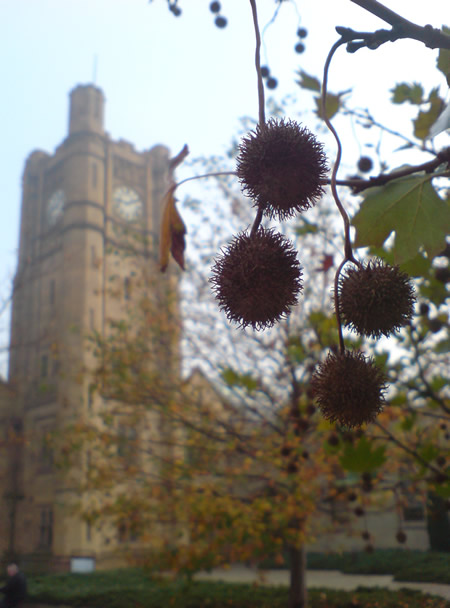
Photo: Clock at University of Melbourne Campus. Picture Credit & copyright © Cobi Smith.
Times Higher Education has announced that its World Academic Summit would take place at the University of Melbourne, Australia, between 30 September and 2 October 2015 and would bring together world leaders from universities, government, and industry to explore the future of world class universities.
The summit will host the official worldwide launch of the 2015-16 Times Higher Education World University Rankings on 1 October, and will have sessions looking at the development of future Nobel laureates, the changing trends in international student mobility, the civic role of globally-focussed universities, international research collaboration, the development of metrics & indicators of research success, and the teaching innovations required to nurture the future generation of global leaders.
Nicolas Dirks, the chancellor of the University of California, Berkeley, will be one of several high profile keynote speakers. Berkeley is consistently ranked in the top ten universities in the world and is one of the six global university “super brands” identified by the THE World Reputation Rankings. His presentation will encompass Berkeley’s ambitious plans for a new “global campus” in California, and will address the subject: “The future of the world class university”.
Sarah Springman, the rector of Switzerland’s ETH Zurich, the world’s highest ranked university outside of the US and UK, will also take part in the summit. She will be joined by Ed Byrne, the president of one of the world’s fastest rising universities, King’s College London, Kap-Young Jeong, the president of South Korea’s Yonsei University as well as Simon Gaskell, principal of Queen Mary University of London and many others.
Brian Schmidt, winner of the 2011 Nobel prize for physics and an astronomer at the Research School of Astronomy and Astrophysics, who was this week confirmed as the next vice chancellor of the Australian National University, will also take part.
Phil Baty, editor of the THE’s portfolio of global rankings, will formally launch the 2015-16 results of the THE World University Rankings. According to Mr. Baty, “The Times Higher Education World Academic Summit brings together a truly exceptional group of people from all across the world. There is no better annual gathering for a select group of university leaders from all over the world to unite behind the common goals of top global universities - nurturing the next generation of world leaders, fostering intercultural understanding, pushing forward the boundaries of human knowledge and transferring that knowledge from the laboratories and classrooms to the wider world.”
|GlobalGiants.Com|







Edited & Posted by Editor | 12:09 AM | Link to this Post
June 21, 2015
UN Celebrates International Day of Yoga
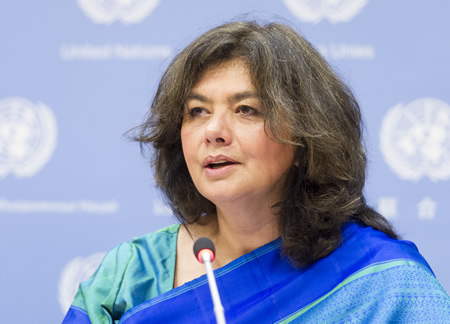
Photo: Nata Menabde, Executive Director of the New York Office of the World Health Organization (WHO), briefs journalists on the first-ever International Day of Yoga, which is being observed on 21 June. United Nations, New York. UN Photo/Mark Garten.
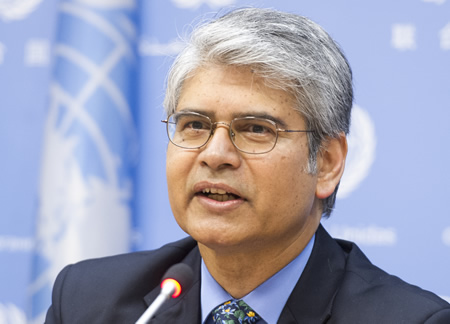
Photo: Asoke Kumar Mukerji, Permanent Representative of India to the United Nations, briefs journalists on the first-ever International Day of Yoga, which is being observed on 21 June. United Nations, New York. UN Photo/Mark Garten.
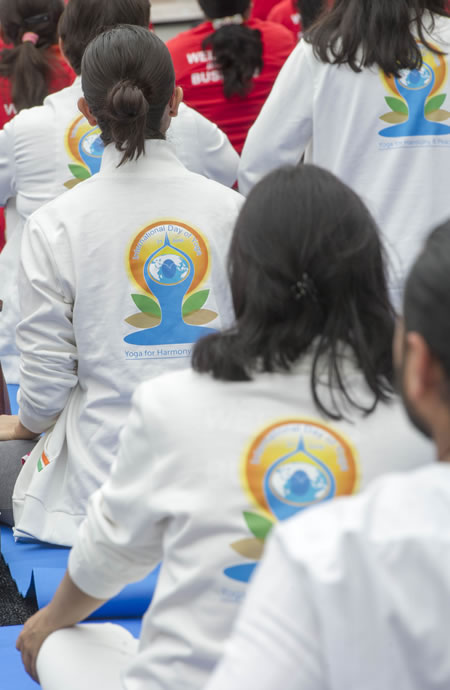
Photo: UN Celebrates International Day of Yoga. A view of participants at the special event celebrating the first International Day of Yoga at UN Headquarters. The first International Day of Yoga is being celebrated around the world following the United Nations General Assembly’s recognition of the holistic benefits of this ancient Indian practice and its inherent compatibility with the principles and values of the UN. 21 June 2015. United Nations, New York. UN Photo/Mark Garten.
|GlobalGiants.Com|
“Calming the mind of its oscillations is the essence of yoga.”
— Maharishi Patanjali, Yoga Sutras.







Edited & Posted by Editor | 11:47 AM | Link to this Post
June 10, 2015
Progress for Chinese Universities in QS University Rankings: Asia 2015

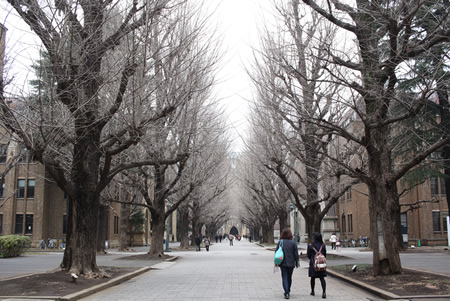
Photo: On the day before the entrance exam. The University of Tokyo, Japan. Image Credit: Yasuhiro HATA.
The QS University Rankings: Asia 2015, released today, reveals strong progress for leading universities in China. The nation accounts for a quarter of Asia’s top 100 universities, and of these 25 leading Chinese universities, 16 have this year improved their positions in the ranking.
These gains have largely been driven by improvements in research productivity, reflecting sustained high levels of public and private investment, though this has yet to fully translate into comparably high levels of research impact, assessed by calculating citations per paper.
China’s highest-ranked institution, Peking University, climbs one place this year to reach 7th place. It’s closely followed by Tsinghua University, which has gained three positions to rank 11th.
Meanwhile the National University of Singapore (NUS) retains the overall top spot in the ranking, with fellow Singapore institution Nanyang Technological University (NTU) climbing from 7th to 4th. Hong Kong and South Korea also retain a strong presence among Asia’s higher education elite, claiming the remaining top-10 positions.
Published annually since 2009, the QS University Rankings: Asia highlights the top 300 universities in Asia, based on a methodology designed to reflect regional challenges and priorities. After China, which has 74 entries overall, Japan remains the most-represented country in the ranking, with 68 Japanese institutions featured. Next is South Korea, taking 45 places, followed by Taiwan (28), Malaysia (21) and India (17).
The other Asian countries featured in the top 300 are: Thailand (11 universities), Pakistan (10), Hong Kong (7), Indonesia (7), Philippines (4), Singapore, Vietnam and Bangladesh (2), Sri Lanka, Brunei and Macau (1).
Click to View the Rankings:
• QS Asia University Rankings 2015 — TOP TWENTY
• QS Asia University Rankings 2015 — INDIA
• QS Asia University Rankings 2015 — PAKISTAN
• QS Asia University Rankings 2015 — BANGLADESH
|GlobalGiants.Com|







Edited & Posted by Editor | 9:29 AM | Link to this Post











